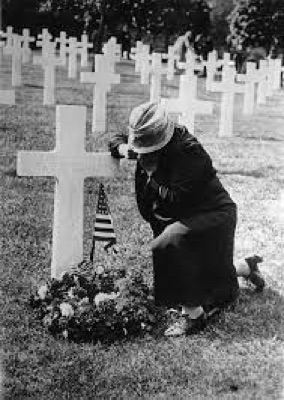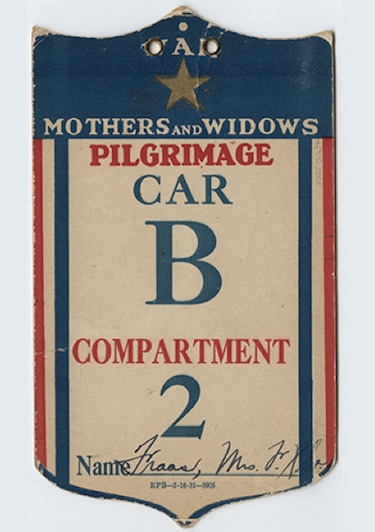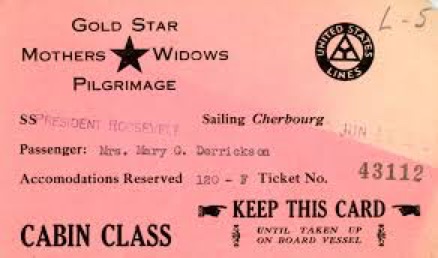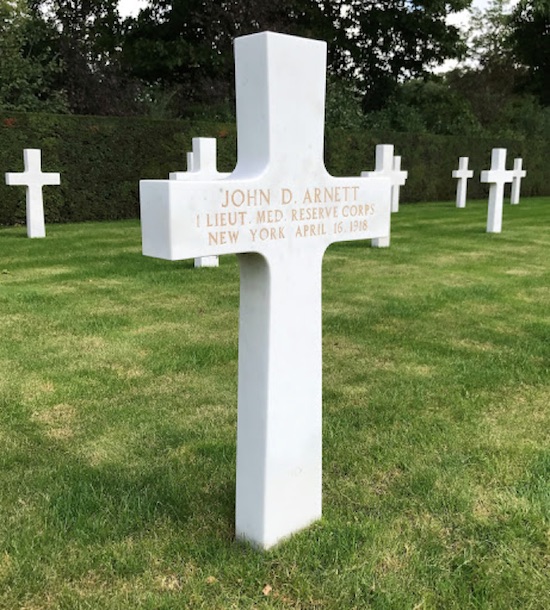Gold Star Mothers from Orleans made remarkable trip in 1931 to Europe
By Catherine Cooper, Orleans County Historian
“Illuminating Orleans” – Vol. 1, No. 13

A Gold Star pilgrimage mother at the grave of her son.
We are familiar with the term “Gold Star Mother” as a reference to those mothers whose son or daughter died or became missing in action while serving with the United States Armed Forces.
The symbol which originated in World War I referred to the flags hung by servicemen’s families in the windows of their homes. Each living family member in the Armed Forces was represented by a blue star. A gold star represented a son or daughter who had died in combat.
The World War I Gold Star Mother Pilgrimages are less well known. This unique program acknowledged the grief of those mothers and widows whose loved ones had perished in the Great War and who were buried in Europe. It also acknowledged the healing power of standing by a loved one’s place of burial.
Wartime burial of the deceased servicemen of WWI was a daunting task as well as a sensitive and hotly debated one. Some soldiers indicated their wishes to their families. Quentin Roosevelt, for example, told his family to “Let the young oak lie where it fell.” Others indicated that they wished to be buried alongside their brothers-in-arms. The Allies felt that the war dead should be buried in Europe, honoring their sacrifice for the land they fought to free. But many families chose repatriation and about 46,000 remains were returned. Some 30,791 were buried in Europe, in eight cemeteries: six in France, one in Belgium and one in England.

Boarding passes and tickets were issued to Gold Star mothers and widows.
After the war, many of the families who could afford to went to visit the grave of their loved one. Accompanied by her son, Theodore Jr., Edith Roosevelt went to visit her son Quentin’s grave in France in Feb. 1919. Poet Joyce Kilmer’s parents visited his grave in Sept. 1920. These visits were publicized, and they encouraged other families to do likewise. Throughout the 1920’s Gold Star Mothers traveled on privately funded trips, or in 1929, as part of the American Legion’s 2nd American Expeditionary Force Convention held in Paris in 1927.
Congressman Fiorello LaGuardia, NY, introduced the first bill proposing publicly funded European cemetery visits for mothers, fathers and widows of servicemen. The bill was defeated, but a bill finally passed in 1929 which authorized the Secretary of War to arrange for pilgrimages to the European cemeteries: “by mothers and widows of members of military and naval forces of the United States who died in the service at any time between April 5, 1917, and July 1, 1921, and whose remains are now interred in such cemeteries.”
Later, mothers and widows of men who died and were buried at sea or who died at sea or overseas and whose places of burial were unknown were also included for eligibility.
The Office of the Quartermaster General, under the supervision of Major-General Cheatham, was charged with overseeing the program which was to run from 1930-1933. Those who had visited the graves were not eligible. Also, widows who had remarried were not eligible. It was determined that 17,389 women were eligible. Then came the daunting task of contacting them. Many had moved, remarried or died since the end of the war and indeed, many letters were returned unclaimed. There were 11,780 responses. But many of those who responded declined the offer, due to age or ill-health.

An article in the Medina Daily Journal March 7, 1930, indicated that seven Gold Star Mothers from Orleans County were deemed eligible:
- Mrs. Virginia Arnett of Millville, whose son, Dr. John Arnett, was a first lieutenant with the Medical Reserve Corps and who was buried in Flanders Field.
- Mrs. Lillian A. Brooks, 13 East Ave., Albion, whose son, Jesse S. was a private with Company E of the 108th Infantry and who was buried at Somme.
- Mrs. Orrin F. Butts of Medina, whose son, Revenue James, was a private with Company B of the 53rd Engineers and who was buried at Oisne-Aisne.
- Mrs. Edna A. Clark of 357 South Ave., Medina, whose son James P. a corporal in Company F. of the 108th Infantry and who was buried at Somme.
- Mrs. Ester Kuramski, of 7 Brown St., Albion, whose son, John, was a private in the 51st Company of the 5th Regiment of the United States Marine Corps and who was buried at Oisne-Aisne.
- Mrs. Grace Mott, of 738 Church St., Medina, whose son, Dewey Graydon was a private in the 82nd Company of the 6th Regiment, United States Marine Corps and who was buried at Oisne-Aisne.
- Mrs. Effa Stevens of 21 West State St., Albion, whose son, John H., was a second lieutenant with the 147th Aero Squadron and who was buried at Oisne-Aisne.

Grave of Lieut. Dr. John D. Arnett of Millville is shown at Flanders Field, Belgium. His mother visited the site on a trip in 1931 for Gold Star Mothers.
The Medina Daily Journal of April 10, 1931, reported that three of the mothers planned to make the trip. Mrs. Effa Stevens of Albion was to sail on the liner America on May 13, while Mrs. Edna Clark and Mrs. Virginia Arnett were to sail on June 25 on the President Roosevelt.
Upon their return, Mrs. Arnett and Mrs. Clark reported in the Medina Daily Journal of July 27, 1931, that every consideration had been shown them on their trip. They enjoyed a calm voyage along with a group of 99 other Gold Star Mothers and Widows. Two of the mothers on board had lost sons at sea and memorial services for these men were held on the journey over.
The group spent several days in Paris and then divided into groups of 25 for the visits to the cemeteries. Each group had a doctor, two nurses and a lieutenant in attendance. Mrs. Clark recounted that there was an American caretaker at each cemetery, and that the white marble headstones were polished to a glittering brightness. Flowers could not be planted on the graves and the grass was close trimmed. Each mother was given a large bouquet of cut flowers and a large wreath to place on the grave and was allowed time at the grave. An official photographer captured the image of each woman at her loved one’s grave. The groups stayed in the vicinity for a few days, so that mothers could get a sense of the area where their son or husband had died.
Following a few days of relaxation in Paris, they returned on the President Washington. They encountered rough seas which lasted for four days but arrived safely home. They felt much comforted by the trip.
For additional information on this remarkable event, read The Gold Star Mother Pilgrimages of the 1930’s by John W. Graham, available through the NIOGA Library System.



































































